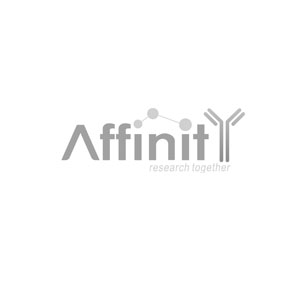PEAR1 Antibody - #DF14281
| Product: | PEAR1 Antibody |
| Catalog: | DF14281 |
| Description: | Rabbit polyclonal antibody to PEAR1 |
| Application: | ELISA(peptide) |
| Reactivity: | Human, Mouse, Rat |
| Mol.Wt.: | 111kD(Calculated). |
| Uniprot: | Q5VY43 |
Related Downloads
Protocols
Product Info
*The optimal dilutions should be determined by the end user.
*Tips:
WB: For western blot detection of denatured protein samples. IHC: For immunohistochemical detection of paraffin sections (IHC-p) or frozen sections (IHC-f) of tissue samples. IF/ICC: For immunofluorescence detection of cell samples. ELISA(peptide): For ELISA detection of antigenic peptide.
Fold/Unfold
hPEAR1; JEDI; MEGF12; Multiple EGF-like domains protein 12; Multiple epidermal growth factor-like domains protein 12; Pear1; PEAR1_HUMAN; Platelet endothelial aggregation receptor 1; RP11-107D16.3;
Immunogens
A synthesized peptide derived from Human PEAR1.
Expressed in umbilical vein endothelial cells and platelets (at protein level). Expressed in heart, kidney, skeletal muscle, pancreas, ovary, breast, lung, brain cortex, hypothalamus, spinal cord, dorsal root ganglion, endothelial cells of umbilical cord artery and vein, megakaryocytes, osteoblasts, coronary muscle and erythroid cells. Weakly expressed in peripheral blood leukocytes and macrophages.
- Q5VY43 PEAR1_HUMAN:
- Protein BLAST With
- NCBI/
- ExPASy/
- Uniprot
MSPPLCPLLLLAVGLRLAGTLNPSDPNTCSFWESFTTTTKESHSRPFSLLPSEPCERPWEGPHTCPQPTVVYRTVYRQVVKTDHRQRLQCCHGFYESRGFCVPLCAQECVHGRCVAPNQCQCVPGWRGDDCSSECAPGMWGPQCDKPCSCGNNSSCDPKSGVCSCPSGLQPPNCLQPCTPGYYGPACQFRCQCHGAPCDPQTGACFCPAERTGPSCDVSCSQGTSGFFCPSTHSCQNGGVFQTPQGSCSCPPGWMGTICSLPCPEGFHGPNCSQECRCHNGGLCDRFTGQCRCAPGYTGDRCREECPVGRFGQDCAETCDCAPDARCFPANGACLCEHGFTGDRCTDRLCPDGFYGLSCQAPCTCDREHSLSCHPMNGECSCLPGWAGLHCNESCPQDTHGPGCQEHCLCLHGGVCQATSGLCQCAPGYTGPHCASLCPPDTYGVNCSARCSCENAIACSPIDGECVCKEGWQRGNCSVPCPPGTWGFSCNASCQCAHEAVCSPQTGACTCTPGWHGAHCQLPCPKGQFGEGCASRCDCDHSDGCDPVHGRCQCQAGWMGARCHLSCPEGLWGVNCSNTCTCKNGGTCLPENGNCVCAPGFRGPSCQRSCQPGRYGKRCVPCKCANHSFCHPSNGTCYCLAGWTGPDCSQPCPPGHWGENCAQTCQCHHGGTCHPQDGSCICPLGWTGHHCLEGCPLGTFGANCSQPCQCGPGEKCHPETGACVCPPGHSGAPCRIGIQEPFTVMPTTPVAYNSLGAVIGIAVLGSLVVALVALFIGYRHWQKGKEHHHLAVAYSSGRLDGSEYVMPDVPPSYSHYYSNPSYHTLSQCSPNPPPPNKVPGPLFASLQNPERPGGAQGHDNHTTLPADWKHRREPPPGPLDRGSSRLDRSYSYSYSNGPGPFYNKGLISEEELGASVASLSSENPYATIRDLPSLPGGPRESSYMEMKGPPSGSPPRQPPQFWDSQRRRQPQPQRDSGTYEQPSPLIHDRDSVGSQPPLPPGLPPGHYDSPKNSHIPGHYDLPPVRHPPSPPLRRQDR
Research Backgrounds
When overexpressed, reduces the number of both early and late non-adherent myeloid progenitor cells.
Phosphorylated in the intracellular domain on tyrosine residues (By similarity). Phosphorylated on tyrosine residues by SRC. Tyrosine phosphorylation is detected upon platelet aggregation stimulated by collagen, TRAP and thrombin and platelet-platelet contacts but not after platelet activation. Tyrosine phosphorylation enhanced its association with SHC1 and SHC2.
Cell membrane>Single-pass membrane protein.
Note: Detected on the cell surface in resting platelets.
Expressed in umbilical vein endothelial cells and platelets (at protein level). Expressed in heart, kidney, skeletal muscle, pancreas, ovary, breast, lung, brain cortex, hypothalamus, spinal cord, dorsal root ganglion, endothelial cells of umbilical cord artery and vein, megakaryocytes, osteoblasts, coronary muscle and erythroid cells. Weakly expressed in peripheral blood leukocytes and macrophages.
Interacts with SHC2 upon its aggregation-induced tyrosine phosphorylation.
Belongs to the MEGF family.
Restrictive clause
Affinity Biosciences tests all products strictly. Citations are provided as a resource for additional applications that have not been validated by Affinity Biosciences. Please choose the appropriate format for each application and consult Materials and Methods sections for additional details about the use of any product in these publications.
For Research Use Only.
Not for use in diagnostic or therapeutic procedures. Not for resale. Not for distribution without written consent. Affinity Biosciences will not be held responsible for patent infringement or other violations that may occur with the use of our products. Affinity Biosciences, Affinity Biosciences Logo and all other trademarks are the property of Affinity Biosciences LTD.
